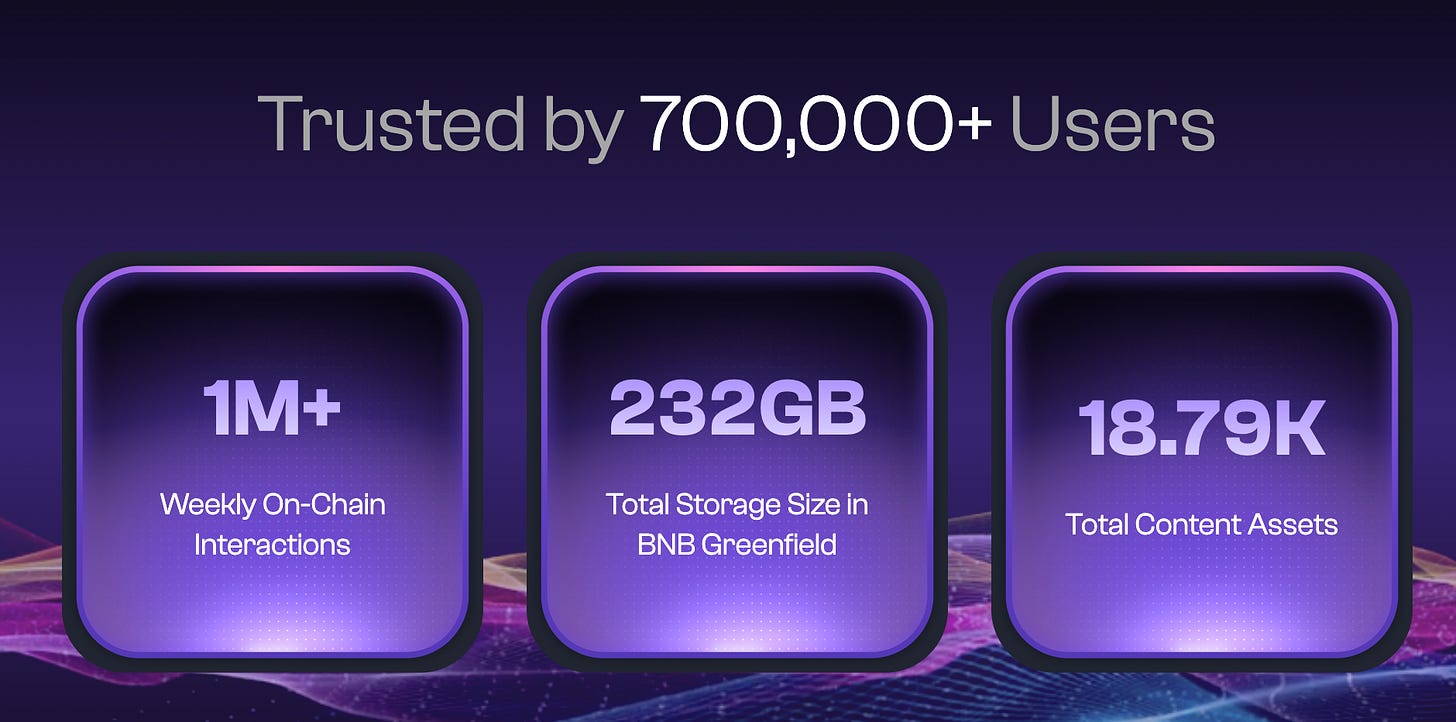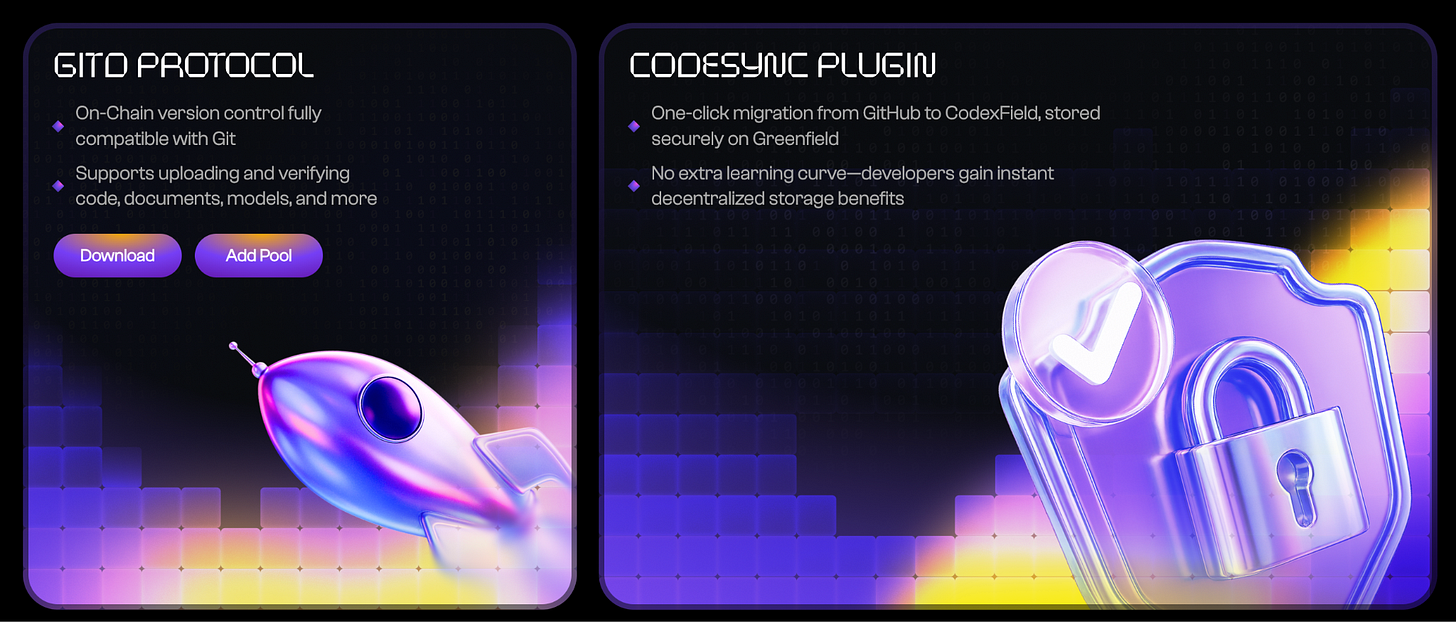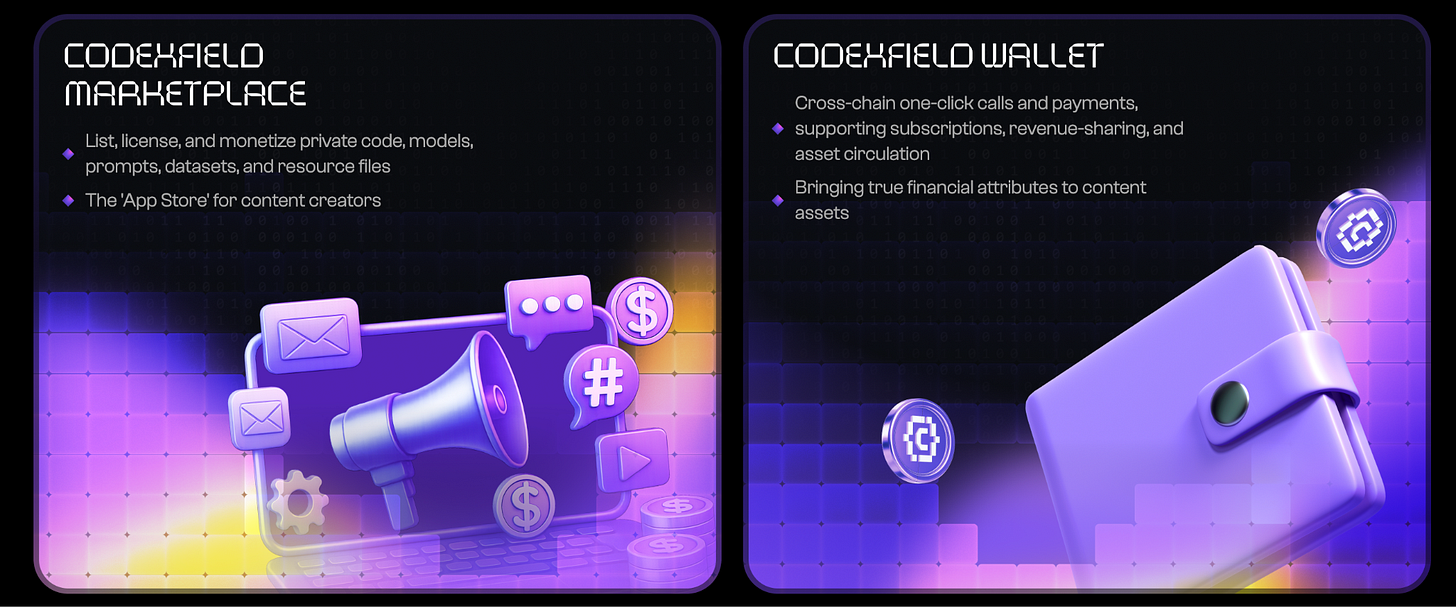Why CodexField Is GitHub's Decentralised Challenger ⌨️
Where code becomes property and usage becomes revenue
You’ve spent months building an open-source library that solves a genuine problem. Thousands of developers use it. Companies integrate it into their production systems. Your code generates real economic value across the industry.
Your compensation? A few GitHub stars and maybe some job offers.
Meanwhile, the platforms hosting your code run ads, sell enterprise plans, and occasionally decide which countries can or cannot access certain repositories. Your intellectual property exists at the mercy of centralised platforms that can remove, restrict, or monetise access without giving you a cut.
The economic model is broken. Developers create value, platforms extract rent, and actual creators get recognition but rarely revenue.
CodexField addresses this misalignment directly. It’s a decentralised platform built on BNB Greenfield that transforms code, AI models, and datasets into tradable assets with verifiable ownership and automated revenue distribution. The platform won first prize at BNB Chain’s Hackvolution hackathon and now serves over 700,000 users with more than 1 million weekly on-chain interactions. More importantly, it’s proving out a new economic model where developers can monetise their work through usage-based billing rather than hoping someone hires them or sponsors their Patreon.
The GitHub Problem
GitHub hosts over 100 million repositories and serves as critical infrastructure for global software development. The underlying Git technology remains distributed, so users can still clone repositories fully, but GitHub adds a centralised management layer on top for convenience and coordination.
Geographic restrictions can block entire countries from accessing repositories based on US trade policy. In 2019, developers in Iran, Syria, and Crimea suddenly lost access to private repositories and certain GitHub features due to sanctions compliance. Your code, your account, subject to geopolitical decisions you have no control over.
Content takedowns happen regularly, sometimes for legitimate copyright reasons but occasionally due to political pressure or corporate disputes. The YouTube-dl repository, a tool for downloading videos was removed and later restored after backlash. During that window, thousands of projects depending on that code faced broken builds and deployment issues.
Monetisation remains indirect and inefficient. Open source developers rely on donations, consulting gigs, or corporate sponsorship rather than being compensated directly for code usage. The GitHub Sponsors program helps but doesn’t fundamentally change the economic model — you’re still dependent on voluntary contributions rather than capturing value from actual usage.
The ownership ambiguity creates disputes over intellectual property rights. When multiple contributors work on a project, determining fair compensation or licensing terms becomes a legal nightmare. Traditional platforms lack mechanisms for transparent, automated revenue sharing that scales across global collaborations.
Most developers have internalised these limitations as unavoidable features of centralised platforms. CodexField’s thesis is that blockchain infrastructure eliminates the need for these compromises.
How Content Assetisation Actually Works
CodexField introduces “Content Capsules,” which is a mechanism that packages code, AI models, datasets, or documentation into verifiable digital assets with embedded ownership, permissions, and pricing logic.
When you upload code to CodexField, the platform generates an on-chain certificate tied to your wallet address. This certificate records the content hash, creation timestamp, and initial access permissions. Think of it as an NFT, but for functional code assets rather than collectible images. The difference is crucial, because these tokens represent actual utility and economic value rather than speculative trading.
The system supports sub-content authorisation, meaning different components of a project can have distinct licensing terms. Your core algorithm might be premium-only while documentation remains freely accessible. Implementation details could be subscription-based while the high-level architecture is open source. This granular control lets developers monetise their work strategically rather than making everything free or everything paid.
Smart contracts enforce these permissions automatically. When someone wants to use your code, they interact with the smart contract that checks their credentials, processes payment, and grants access. All without manual intervention or platform intermediaries taking a cut beyond standard gas fees. The AI integration adds another layer by evaluating code quality based on structure, documentation completeness, and usage patterns, generating quality scores that improve discoverability.
Revenue distribution happens automatically based on usage metrics. Every time someone accesses, downloads, or invokes your content, the smart contract routes payment according to predefined terms. For collaborative projects, revenue splits between contributors automatically without needing payment processors or accountants.
The technical implementation uses BNB Greenfield for primary storage, with additional integrations across Arweave for permanent archival, Filecoin for cost-efficient bulk storage, and CESS for privacy-enhanced storage. This multi-chain approach optimises for cost, durability, and performance depending on content requirements.
What CodexField Does and How It Works
CodexField is a complete ecosystem for turning code and AI assets into revenue-generating property.
Gitd Protocol
The Gitd Protocol extends Git functionality to decentralised storage without changing the command-line experience. You use familiar commands like gitd clone and gitd push, but your code gets stored on Greenfield instead of GitHub’s servers. Each repository receives an on-chain certificate that establishes verifiable ownership tied to your wallet address. Your full commit history, branches, and tags work identically to centralised Git.
CodeSync Plugin
CodeSync handles one-click migration from GitHub, preserving your complete project history. Every commit, branch, tag, and metadata. You can continue pushing to GitHub while also syncing to CodexField, effectively creating a decentralised backup with monetisation capabilities. The migration automatically generates ownership certificates for all your repositories.
CodexField Marketplace
The marketplace operates like an app store for developer assets. Creators list code, models, or datasets with configurable pricing - one-time purchases, subscriptions, usage-based billing, or custom licensing. Discovery happens through AI-powered recommendations and semantic search that match queries against metadata from all listed assets. On-chain reviews tied to buyers’ wallets prevent fake ratings while maintaining privacy.
CodexField Wallet
The wallet handles cross-chain payments without requiring users to understand blockchain complexity. The system supports crypto transfers, credit card purchases that auto-convert, and subscription management with automatic recurring payments. Revenue sharing happens instantly through smart contracts. If three developers split revenue 50/30/20, every payment divides according to these terms automatically.
AI Content Analysis
AI Content Analysis evaluates uploaded content through multiple mechanisms examining code structure, documentation completeness, security practices, and performance metrics. The system generates quality scores and applies semantic tags categorising content by language, use case, and complexity. For AI models and datasets, this includes performance benchmarks, bias detection, and compatibility checks.
Revenue Pools
Revenue Pools bring DeFi mechanics to content monetisation, allowing liquidity providers to invest in curated collections of content assets and earn returns based on actual usage. FastYield pools focus on high-frequency content, SubFlow pools target subscription-based revenue, and Endurance pools invest in long-term licensing. Developers can also use verified content assets as collateral for loans, borrowing against future income streams rather than taking VC funding.
What’s Actually Different Here
The content assetisation concept isn’t entirely new. NFT platforms have attempted similar ideas with mixed results. CodexField’s differentiation comes from building specifically for developer workflows rather than treating code as generic digital files.
The Git compatibility means developers can adopt CodexField incrementally without abandoning existing tools. You don’t need to choose between GitHub and CodexField. You can use both, maintaining your current workflow while experimenting with decentralized storage and monetisation. This lowers the adoption barrier significantly compared to platforms that require complete workflow changes.
The multi-chain storage integration optimises for performance and cost rather than betting on a single blockchain solution. By combining BNB Greenfield’s efficiency, Arweave’s permanence, and Filecoin’s cost-effectiveness, CodexField offers flexibility that single-chain platforms cannot match. If one storage network becomes expensive or unreliable, the platform can shift load to alternatives without disrupting users.
Adoption requires network effects. The platform becomes more valuable as more developers and companies participate, but reaching critical mass is challenging when competing with entrenched alternatives like GitHub that work well enough for most use cases.
The projected growth of AI-generated content to exceed $100 billion by 2030 creates significant opportunities for platforms that can establish ownership, licensing, and monetisation standards early. CodexField’s positioning at the intersection of code storage, AI assets, and blockchain puts it in position to capture value from this trend.
CodexField addresses real friction in how developers create, share, and monetise code. The platform’s traction suggests developers are ready for alternatives to centralised code hosting, especially when those alternatives offer concrete economic benefits rather than just ideological decentralisation. Whether CodexField specifically becomes the dominant player or inspires better solutions, the concept of code as programmable, tradable assets with automated revenue distribution represents a meaningful evolution in developer economics.
For an industry built on open collaboration, that’s worth paying attention to.
Token Dispatch is a daily crypto newsletter handpicked and crafted with love by human bots. If you want to reach out to 200,000+ subscriber community of the Token Dispatch, you can explore the partnership opportunities with us 🙌
📩 Fill out this form to submit your details and book a meeting with us directly.
Disclaimer: This newsletter contains analysis and opinions of the author. Content is for informational purposes only, not financial advice. Trading crypto involves substantial risk - your capital is at risk. Do your own research.








